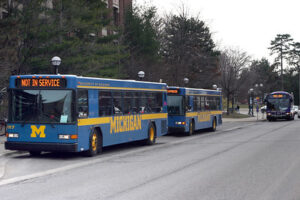When you hear about college recruiting, the discussion usually focuses on sports like football or basketball. But schools that haven’t had to recruit in the past are going to need to learn how. Michigan Reconnect has done a lot of heavy lifting – at least on the surface. Paying for community college courses should be a big draw, but there’s still a big gap between the number of Michigan Reconnect applicants and the number of enrolled students.
College recruiting for non-athletes shouldn’t be limited to recent high school graduates or students over the age of 25. Community college administrators need to understand, however, that there’s a little more involved than just dangling the word “free.” The median age in Washtenaw County right now is approaching 35. For a community college, the age of the student is neither here nor there, but older students do have needs that recent high school graduates don’t.
Older students are more likely to have a job, so they need to fit classes around their often non-negotiable work schedules. Offering required classes only during the day or only at night isn’t going to work for the student who already has a job. Scheduling class time is a major challenge. The traditional 15-week semester doesn’t work for most people who are returning to school. Attending school part-time could require a person to commit to four years of piecemeal efforts to complete a degree program.
Older students are also more likely to have large expenses, like housing, childcare, and transportation. Like their work schedules, their bills are also not negotiable. They need degree programs that will enable them to earn a salary that exceeds what they’re already earning.
Can community college recruiting succeed?
I don’t know this for a fact, but I suspect that most of the Michigan Reconnect no-shows have done the math and discovered that new degrees won’t allow them to earn substantially more than they do right now. That’s a failure on the part of community college administrators to maintain their course catalogs and facilities. It’s also a failure of oversight. Most often, people don’t do what they’re not required to do. As long as elected trustees do not demand regular investment into instruction, it won’t happen.
Family demands also weigh heavily on older students. Eliminating on-campus childcare likely eliminated the opportunity for a lot of students to attend classes. Vouchers and subsidies do no good when there’s simply no childcare to be had. Personally, I would be in favor of the State of Michigan requiring all publicly funded community colleges to provide licensed on-campus childcare.
In Washtenaw County, Manchester, Milan, and Ypsilanti all have comparatively low post-secondary educational attainment levels. In these areas, 50% or less of the adult population has at least an associate degree. Comparatively, about 8 out of 10 Ann Arbor residents already have at least 60 college credits. Simply recruiting new students in these locations may not be enough. Establishing well equipped satellite campuses might enable more students to enroll.
There are a lot of things the community colleges could be doing besides waiting for students to show up. Doing nothing is always the easiest approach, but it’s normally also the least productive.
Photo Credit: Brandon Warren, via Flickr































